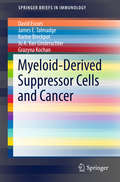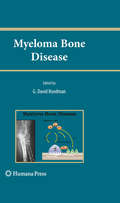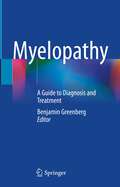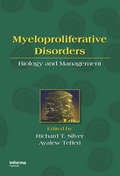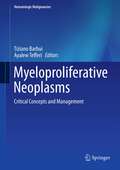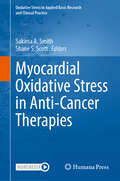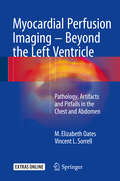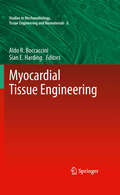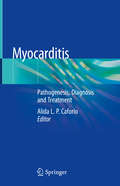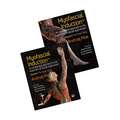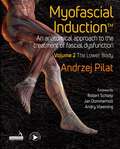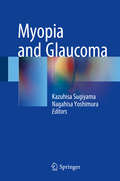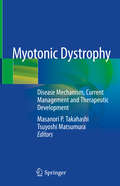- Table View
- List View
Myeloid-Derived Suppressor Cells and Cancer
by David Escors Grazyna Kochan Karine Breckpot James E. Talmadge Jo A. GinderachterThe book starts with an introduction to and history of myeloid-derived suppressor cells (MDSCs), followed by a description of their differentiation, their role in the tumour microenvironment and their therapeutic targeting. It closes with an outlook on future developments. In cancer patients, myelopoiesis is perturbed and instead of generating immunogenic myeloid cells (such as dendritic cells, inflammatory macrophages and granulocytes), there is an increase in highly immature MDSCs. These cells are distributed systemically, resulting in general immunosuppression. They also infiltrate tumours, promoting their progression and metastasis by inhibiting the natural anti-tumour immune response. As these cells also interact with classical anti-neoplastic treatments, they have become major therapeutic targets in the pharmaceutical industry and in oncology research.
Myeloma Bone Disease
by G. David RoodmanThis state-of-the-art book presents the forefront in the science and clinical management of myeloma bone disease. Assembling the work of the world's premier thought leaders, this book begins with sections on clinical presentation, imaging, and biochemical markers and then goes on to discuss radiation, surgical, and medical therapies. Specific chapters are devoted to bisphosphonates and novel therapeutic agents, such as RANKL inhibitors, Wnt signaling inhibitors, and IMiDs. The mechanisms of osteoclast activation and osteoblast suppression in multiple myeloma are also explored. Myeloma Bone Disease is a valuable resource for medical, surgical, and radiation oncologists and cancer researchers.
Myeloma Therapy
by Sagar LonialTherapeutic options for patients with myeloma have radically changed over the past ten years. Beginning with the advances in therapy resulting from the use of high dose therapy and autologous bone marrow or stem cell transplant, we have more than doubled the median survival for patients as a whole, and have now a wealth of different biology based treatment approaches for our patients in all disease stages. The purpose of this book is to update the various treatment options for patients with myeloma, as well as to focus on the emerging and speculative aspects of myeloma therapy. This will require review of basic mechanisms of disease as well as further discussions on how these mechanisms can best be targeted. While there will be text covering most areas of myeloma therapy, the prime focus of the book will be the novel agents currently in testing as well as potential future novel targets and agents.
Myeloma: Pathology, Diagnosis, and Treatment
by Kenneth C. Anderson Stephen A. Schey Kwee L. Yong Robert Marcus Stephen A. Schey Kwee L. Yong Robert MarcusMyeloma is the second-most common hematologic cancer, accounting for approximately 1 percent of all cancers and 2 percent of all deaths from cancer. In recent years there have been major and significant advances in the diagnosis, imaging, molecular pathogenesis, and therapy of myeloma. This book describes these advances in a single, practical volume, placing them in the context of daily clinical practice. Different myeloma subtypes are discussed in individual chapters, integrating etiology, pathogenesis, molecular pathology, histology, and therapy in a single place for each condition. The book begins by discussing epidemiology, imaging techniques, pathogenesis, and other general considerations. Conditions covered in detail include multiple myeloma, POEMS syndrome, Castleman's syndrome, Waldenstrom's macroglobulinemia, amyloidosis and MGUS. Featuring color illustrations, and written and edited by leading authorities in the field, Myeloma provides readers with the information they need to diagnose and manage these complex disorders.
Myelopathy: A Guide to Diagnosis and Treatment
by Benjamin GreenbergDisorders of the spinal cord are diverse and potentially devastating. They can present as acute, subacute and chronic disorders causing a variety of symptoms. Patients can present to pediatricians, internists, OBGYNs, emergency room physicians and neurologists requiring a diversity of clinicians to be familiar with the signs, symptoms, recommended testing and treatment options. This book comprehensively addresses myelopathies, the broad spectrum of potential pathologies. Chapters cover approaches to acute, subacute and chronic myelopathies; individual myelopathic disorders; the pathobiology, epidemiology, signs, and symptoms of the disorder; diagnostic approach, and therapeutic options. This comprehensive review is beneficial to any clinician, with special emphasis for neurologists, neurosurgeons, neuroradiologists and physiatrists.
Myeloproliferative Disorders: Biology and Management
by Ayalew Tefferi Richard T. SilverWith the recent discovery of JAK2 mutations in myeloproliferative disorders, medical science has taken a revolutionary stride forward toward understanding the pathogenesis of these diseases. This new advancement translates not only to a more rapid and reliable diagnosis, but also allows groundbreaking research into the development of new therapeuti
Myeloproliferative Neoplasms
by Ayalew Tefferi Srdan VerstovsekThis succinct resource provides an ideal balance of the biology and practical therapeutic strategies for classic and non-classic BCR-ABL-negative myeloproliferative neoplasms. Utilizing current World Health Organization nomenclature, classification, and diagnostic criteria, international experts have assembled to convey the most up-to-date knowledge in this rapidly evolving field. The opening chapters cover the diagnosis and classification, genetics, cytogenetic findings, and prognostic factors of MPNs. Further chapters explore therapies specific to the different disease entities, including polycythemia vera, essential thrombocytopenia, myelofibrosis, and eosinophilic disorders, and mastocytosis. Unique areas of discussion include JAK2 inhibitor therapy, hematopoietic stem cell transplantation, and blastic transformation. A valuable reference for practicing hematologists, this forefront book enriches our understanding of recent discoveries and their impact on conventional and investigational treatments.
Myeloproliferative Neoplasms
by Ayalew Tefferi Tiziano BarbuiThis book focuses on three of the main categories of myeloproliferative neoplasm: polycythemia vera, essential thrombocythemia, and primary myelofibrosis. Relevant laboratory and clinical advances are comprehensively covered, and great emphasis is placed on the practical issues that challenge physicians in their daily practice. The main topics considered thus include contemporary diagnostic approaches, the value and limitations of mutation screening for diagnostic and prognostic purposes, risk stratification in terms of both survival and other disease complications such as leukemic transformation and thrombosis, and modern therapeutic strategies, including conventional drugs, allogeneic stem cell transplantation, and experimental drugs still under study. The reader will find Critical Concepts and Management Recommendations in Myeloproliferative Neoplasms to be an invaluable and up-to-date source of information from leading authorities in the field.
Myocardial Oxidative Stress in Anti-Cancer Therapies (Oxidative Stress in Applied Basic Research and Clinical Practice)
by Sakima A. Smith Shane S. ScottThis book summarizes the present knowledge of oxidative stress in anti-cancer drug-induced cardiotoxicity and covers cell molecular mechanisms, prevention and treatment strategies, drug research, and population experiments. Racial and gender disparities in anticancer therapy-related cardiotoxicity are also covered. Book chapters provide current and timely review of hypothesis-driven research, case studies, and review articles. As such, this book serves as a source of knowledge and guidance for research, clinical prevention, and treatment of cardiotoxic anticancer drugs. Furthermore, this book is essential for students, cardiologists, cardio-oncologists, and heart failure researchers.
Myocardial Perfusion Imaging - Beyond the Left Ventricle
by M. Elizabeth Oates Vincent L. SorrellThis book will serve as a comprehensive reference source and self-assessment guide for physicians and technologists who practice myocardial perfusion SPECT imaging. Readers will learn to identify a wide variety of findings apart from the left ventricle, including those in the chest, the abdomen, and the right heart. It is explained which findings are clinically relevant and related to the reason for the myocardial perfusion imaging examination and which are incidental, with or without important clinical ramifications. The coverage includes a wide variety of common and uncommon focal lesions (e. g. , benign or malignant neoplasms) and organ/systemic diseases (e. g. , emphysema, cirrhosis and its sequelae, cholecystitis, duodenogastric reflux/gastroparesis, end-stage renal disease) that may be detected with myocardial perfusion SPECT imaging. In addition, guidance is provided in the recognition of typical artifacts, which may appear either "hot" or "cold" on the raw (unprocessed) and processed SPECT images, and, thereby, in the avoidance of potential interpretative pitfalls.
Myocardial Perfusion Scintigraphy: From Request to Report
by Bob Bury Catherine Dickinson Karen Sheard Penny ThorleyThere is general recognition that nuclear cardiology, and particularly myocardial perfusion scintigraphy (MPS), is under-utilized in the UK when compared with practice in mainland Europe and the USA. The National Institute for Clinical Excellence (NICE) is about to issue a report that will recognize the shortfall in provision, and this should lead
Myocardial Preservation: Translational Research And Clinical Application
by Dennis V. CokkinosThis timely book reveals an integrated approach to myocardial preservation focusing on translational research and clinical applications. Chapters cover both the mechanisms of heart failure in addition to therapeutic considerations, including forms of cardiac cell death, cardiac remodelling and cardiac regeneration. Potential future research directions are also proposed, enabling the reader to gain a broad in-depth understanding of the topic. Myocardial Preservation: Translational Research and Clinical Application presents a thorough review of myocardial preservation. Its comprehensive approach provides a valuable reference for cardiology researchers and practising and trainee cardiologists seeking new insight to the topic.
Myocardial Tissue Engineering
by Aldo R. Boccaccini Sian HardingMyocardial tissue engineering (MTE), a concept that intends to prolong patients' life after cardiac damage by supporting or restoring heart function, is continuously improving. Common MTE strategies include an engineered 'vehicle', which may be a porous scaffold or a dense substrate or patch, made of either natural or synthetic polymeric materials. The function of the substrate is to aid transportation of cells into the diseased region of the heart and support their integration. This book, which contains chapters written by leading experts in MTE, gives a complete analysis of the area and presents the latest advances in the field. The chapters cover all relevant aspects of MTE strategies, including cell sources, specific TE techniques and biomaterials used. Many different cell types have been suggested for cell therapy in the framework of MTE, including autologous bone marrow-derived or cardiac progenitors, as well as embryonic or induced pluripotent stem cells, each having their particular advantages and disadvantages. The book covers a complete range of biomaterials, examining different aspects of their application in MTE, such as biocompatibility with cardiac cells, mechanical capability and compatibility with the mechanical properties of the native myocardium as well as degradation behaviour in vivo and in vitro. Although a great deal of research is being carried out in the field, this book also addresses many questions that still remain unanswered and highlights those areas in which further research efforts are required. The book will also give an insight into clinical trials and possible novel cell sources for cell therapy in MTE.
Myocarditis: Pathogenesis, Diagnosis and Treatment
by Alida L. P. CaforioThis book is an up-to-date, comprehensive, clinically oriented guide to the diagnosis and treatment of patients with myocarditis. The opening chapters address the classification, histopathology and molecular diagnosis, as well as the polymorphic clinical presentations, ranging from myocardial infarction with normal coronary arteries; arrhythmias of variable type and clinical severity and fulminant, acute, sub-acute or chronic heart failure; to life-threatening unexplained cardiogenic shock and sudden cardiac death.Including chapters from leading International experts in the field, it covers all key issues from bench to bedside. Topics presented include epidemiology, etiology, pathogenesis, clinical and diagnostic work-up, the role of endomyocardial biopsy and of non-invasive cardiac imaging, risk stratification, and cardiological and etiology-specific management and follow-up. For each topic, a comprehensive review of the current literature is provided and practical suggestions are offered for short- and long-term management. Lastly, future perspectives and gaps in the current knowledge are also addressed. The book also covers a key discovery of last the 2 decades, namely the autoimmune origin of myocarditis in a sizable proportion of patients, discussing in detail the role of immunosuppression and immunomodulation, as well as the need for a multidisciplinary approach to the disease. Mainly intended for cardiologists, general physicians, clinical immunologists and rheumatologists, it is also a valuable tool for residents in Cardiology, Internal Medicine, Clinical Immunology and Rheumatology.
Myofascial Induction™ 2-volume set: An Anatomical Approach to Fascial Dysfunction
by Andrzej PilatIn these unique and lavishly illustrated books and their accompanying videos, the practitioner can for the first time see the effect of manual interventions on underlying body structures.Using over 700 photographs and diagrams these volumes reveal fascial architecture to the reader in all its glory, and sets out the principles and practice of Myofascial Induction. The author's own teaching and practice provide the material that explains and illustrates fascial anatomy and therapeutic procedures. The beautiful full color photographs and videos of dissections of non-embalmed cadavers show the continuity of the fascial system and its dynamic links to other body systems. By demonstrating the effect that therapy has on body structures the book will be of interest and practical value to the physical therapist, osteopath, chiropractor, physician and all bodyworkers dedicated to manual therapy, as well as to researchers wishing to build on this ground-breaking material.Volume 1 covers the science and principles of Myofascial Induction and its applications to the upper body. Volume 2 addresses its applications to the thoracic and lumbar spine, the pelvis, and the lower body.
Myofascial Induction™ Volume 2: An Anatomical Approach to the Treatment of Fascial Dysfunction
by Andrzej PilatIn this unique and lavishly illustrated book and its accompanying videos the practitioner can for the first time see the effect of manual interventions on underlying body structures. Volume 2 addresses its applications to the thoracic and lumbar spine, the pelvis, and the lower body.The author's own teaching and practice provide the material that explains and illustrates fascial anatomy and therapeutic procedures. The beautiful full color photographs and videos of dissections of non-embalmed cadavers show the continuity of the fascial system and its dynamic links to other body systems. By demonstrating the effect that therapy has on body structures the book will be of interest and practical value to the physical therapist, osteopath, chiropractor, physician and all bodyworkers dedicated to manual therapy, as well as to researchers wishing to build on this ground-breaking material.
Myofascial Induction™: An anatomical approach to the treatment of fascial dysfunction Volume 1: The Upper Body
by Andrzej PilatMyofascial Induction™ - An anatomical approach to the treatment of fascial dysfunction describes the properties of the fascial network and provides therapeutic solutions for different types of fascial dysfunction. The material is presented in two volumes:Volume 1 analyzes in depth the theoretical aspects related to fascia and focuses on the therapeutic procedures of Myofascial Induction Therapy (MIT™) for the upper body; Volume 2 summarizes and expands on the theoretical aspects and explains the therapeutic procedures of MIT for the lower body.Volume 1 is divided into two parts:Part 1 - The Science and Principles of Myofascial Induction andPart 2 - Practical Applications of Myofascial Induction - the Upper Body.Part 1 defines the fascia as a complex biological system before discussing its multiple characteristics.Part 2 is the practical part. Here the reader will find a wide range of manual therapeutic procedures which can be selected and used to build up the MIT treatments. These processes are explained in detail and are richly illustrated, in full color, with diagrams and photographs of their practical application in the body and in the treated samples of dissected tissues.Each chapter opens with an introduction offering to the reader some philosophical background as a reminder that philosophy allows us to relate the strictly scientific with the empirical. Praxis and empiricism are the basis of science.The author invites you to join the scientific fascial adventure that allows us to uncover areas of knowledge which may have been forgotten or which are not yet recognized as being related and which might still reveal relevant information. Once discovered, these facts can help us to better understand the kinesis of our body and so help the individual to change their body image and to improve their quality of life.
Myofascial Pain And Dysfunction: The Trigger Point Manual - The Lower Extremities
by David G. Simons Janet G. Travell...gives a thorough understanding of what myofascial pain actually is, and provides a unique and effective approach to the diagnosis and treatment of this syndrome for the lower body muscles.
Myofascial Pain and Dysfunction: Diagnostics and Therapy
by Rolf Eichinger Kerstin KlinkPatients often seek advice in the doctor's office whose complaints are of a functional nature and cannot be directly assigned to an organ disease via laboratory or imaging. Many of these disorders such as pain, dizziness, tinnitus, lumpiness or the "heel spur" originate from the fascial organ, which is only now slowly being understood as such.Fascia connects all parts of our body mechanically but more important, all our receptors for intro-and extroception and for the regulation of homeostasis are embedded in fascia. If you take this system into account in the differential diagnosis, you can spare your patients invasive, stressful diagnostics and offer an accurate and successful therapy.Understand causes of fascial pain and dysfunction: fascial knots, principals of fascial disorders, flash tests, fascial chains, trigger points, interaction between cause and location of pain or other symptoms like fixed eczema and othersUnderstand causes of myofascial pain and dysfunction: myofascial knots, fascial chains, trigger points, interaction between cause and location of pain. fascial slackness and blockages Clinic, symptoms Recognize fascial syndromes and pain patterns correctly Causal and permanently effective treatment approaches Therapy of the fascial system Causes of fascial disorders Cooperation doctor - physiotherapistThe authors - a general practitioner and a physiotherapist - complement each other perfectly in their knowledge and skills. A plausible, practice-relevant, pathophysiological concept, which was created on the basis of many years of experience and success, as well as scientific studies (where available) and comes up with new - sometimes provocative - theses. For general practitioners, internists, orthopedists, physiotherapists and all physicians who are willing to enrich their diagnostic and therapeutic concepts with a myofascial approach.The translation was done with the help of artificial intelligence. A subsequent human revision was done primarily in terms of content.
Myofascial Release Therapy
by Michael J. Shea Holly PintoMichael Shea, one of the foremost experts on myofascial release, presents straightforward, practical instructions for dramatically releasing pain and restriction of motion in the body's fascia, muscles, and connective tissue. He introduces a soft tissue, hands-on approach for massage therapists, physical therapists, and other healthcare practitioners that reduces tension and stress in their clients' entire myofascial systems, as well as their musculoskeletal and cardiovascular systems. Therapists with little or no background in myofascial release and deep tissue reorganization can follow this book's easy guidelines in order to facilitate substantial orthopedic changes and pain reduction in their clients. Illustrated with 70 black and white photos, Myofascial Release Therapy includes an at-a-glance section that provides a step-by-step procedure for quick reference. Each photo is supplemented with instructions, as well as with arrows for easy reference in the clinic. This book provides the first integration of the verbal, visceral, and palpation skills of the therapist. It also includes work on the viscera as a way of integrating soft tissue work through the abdomen and pelvis. While manuals on the bones, muscles, and viscera have previously been divided into separate volumes, this book combines them into one. The author offers specific tools and protocols for helping patients "destructure" past somatic experience and reform it into something healthier. He illuminates the interconnectedness between bodies and their relationships to the outside world, including how sensations, feelings, and emotions are organized in the body and how they are coupled to meaning and memory. The result of many years of experience and knowledge, this book provides compelling evidence that myofascial release therapy encourages more rapid healing response of injured tissue.
Myofasziale Schmerzen und Funktionsstörungen: Diagnostik und Therapie
by Rolf Eichinger Kerstin KlinkIn der Arztpraxis suchen oft Patienten Rat, deren Beschwerden funktioneller Natur sind und nicht unmittelbar über Labor oder Bildgebung einer Organerkrankung zugeordnet werden können. Zahlreiche dieser Störungen wie Schmerzen, Schwindel, Tinnitus, Kloßgefühl oder der "Fersensporn" kommen aus dem myofaszialen Organ, das erst jetzt langsam als solches begriffen wird.Muskeln und das Netzwerk der Faszien bilden zusammen das im gesamten Körper präsente myofasziale System. Wenn Sie auch dieses System bei der Differentialdiagnose mit berücksichtigen, können Sie Ihren Patienten z.T. invasive, belastende Diagnostik ersparen und eine treffergenaue erfolgreiche Therapie bieten. Ursachen für myofaszial bedingte Schmerzen und Funktionsstörungen verstehen: myofasziale Knoten, Faszienketten, Triggerpunkte, Wechselwirkung zwischen Schmerzursache und SchmerzlokalisationMyofasziale Gelosen und BlockadenKlinik, BeschwerdebilderMyofasziale Syndrome und Schmerzmuster zutreffend erkennenKausale und dauerhaft wirksame BehandlungsansätzeTherapie des myofaszialen SystemsZusammenarbeit Arzt - Physiotherapeut Die Autoren – ein Allgemeinmediziner und eine Physiotherapeutin – ergänzen sich in ihrem Wissen und Können perfekt. Ein plausibles, praxisrelevantes, pathophysiologisches Konzept, das auf Basis langjähriger Erfahrung und Erfolge, sowie wissenschaftlicher Studien (soweit vorhanden) erstellt wurde und mit neuen - manchmal provokanten - Thesen aufwartet.Für Allgemeinmediziner, Internisten, Orthopäden, Physiotherapeuten und alle Ärzte, die bereit sind, ihre diagnostischen und therapeutischen Konzepte mit einem myofaszialen Ansatz zu bereichern.
Myofibroblasts: Methods and Protocols (Methods in Molecular Biology #2299)
by Boris Hinz David LagaresThis detailed book explores the fundamentals of myofibroblast biology in tissue repair, fibrosis, and tumors as well as providing cutting-edge laboratory methods used to investigate myofibroblast functions in physiological and pathological settings in vitro and in vivo, as written by leading academic scientists. Section I of this volume focuses on fundamental methods to study myofibroblast biology and covers topics such as methods for detecting myofibroblasts and senescent myofibroblasts in cell culture and histology, single cell RNA sequencing to identify myofibroblast subsets in fibrotic tissues, and functional assays to assess TGF-β activation, myofibroblast apoptosis, or matrix deposition and crosslinking. Section II discusses methods to investigate the mechanobiology of myofibroblasts in vitro, including the fabrication of functional hydrogels with tunable stiffness, the use of atomic force microscopy to characterize matrix and cellular stiffness, as well as molecular assays to assess fibroblast mechanotransduction pathways and durotaxis. Section III describes multiple animal models to investigate myofibroblast functions across organs in vivo as well as human organoid systems, precision tissue slices and decellularized 3D tissue scaffolds to assess myofibroblast functions in relevant human ex vivo models. Written for the highly successful Methods in Molecular Biology series, chapters include introductions to their respective topics, lists of the necessary materials and reagents, step-by-step, readily reproducible laboratory protocols, and tips on troubleshooting and avoiding known pitfalls. Authoritative and extensive, Myofibroblasts: Methods and Protocols is an essential collection for researchers delving into the processes and effects of these important cells.
Myopericardial Diseases
by Massimo ImazioThis book reviews current knowledge and recent advances in the diagnosis and management of myopericardial diseases, a spectrum of medical diseases and syndromes affecting a significant proportion of patients in clinical practice and presenting either as an isolated process or as a manifestation of a systemic disease. Unlike in other books, both pericardial and myocardial diseases are fully covered. Detailed guidance is provided on diagnosis and the role of integrated cardiovascular imaging, medical therapy, interventional diagnosis and therapy, and surgical diagnosis and therapy. Importantly, up-to-date original information is presented on indications and guidelines/recommendations planned for publication in 2015. This well-illustrated book will be an invaluable aid to diagnosis and management for practitioners in a range of medical specialties, including cardiology, internal medicine, rheumatology, family medicine, cardiac surgery, nephrology, and endocrinology.
Myopia and Glaucoma
by Kazuhisa Sugiyama Nagahisa YoshimuraThis book serves as an introductory reference on clinical aspects of glaucoma and myopia, providing essential guidelines for diagnosis and monitoring of glaucoma progression in patients, especially those with high myopias. Many clinical studies are presented by leading experts in the field in an accessible style, making the content suitable not only for ophthalmologists but also for optometrists and certified orthoptists as well as for students. The relation between myopia and glaucoma has been the subject of many clinical trials and population-based studies. Most of the data has suggested that moderate to high myopia is associated with increased risk of primary open-angle glaucoma, normal tension glaucoma, and ocular hypertension. There are several factors involved in the diagnosis of glaucoma, but it is often difficult to determine the presence of glaucoma in myopic eyes. A myopic eye, especially in cases of moderate to high myopia, tends to have a thin retina and choroid and to appear thinner than normal. Even with new imaging technologies with improved sensitivity and specificity for detecting glaucoma, each technology presents some challenges when assessing myopic eyes. This book furnishes an overview of these diagnostic challenges with reference to the growing prevalence and severity of myopia in various parts of the world, providing many valuable hands-on reports and clinical studies by authoritative authors. This knowledge will help to do away with the vague area between high myopia and glaucoma faced by clinicians.
Myotonic Dystrophy: Disease Mechanism, Current Management And Therapeutic Development
by Masanori P. Takahashi Tsuyoshi MatsumuraThis book provides an essential overview combining both clinical and fundamental research advances in myotonic dystrophy. The pathomechanism of myotonic dystrophy has long been unclear, but in the past decade, our understanding has shifted to a novel disease mechanism concept: “RNA disease”. Parallel to these advances in elucidating the pathophysiology, translational research is also progressing rapidly. The current challenge lies in assessing the effectiveness of treatment, and as such, there is a growing interest in observational studies of the disease’s various clinical symptoms. The book introduces readers to the molecular mechanisms within each organ and the resultant clinical features, which are presented together. In particular, it focuses on the central nervous system, since the pathology of the brain (central nervous system manifestation) has rarely been addressed systematically and will pose a persistent challenge, even if therapies have greatly advanced in the future. In addition, the book addresses the latest developments, such as research using patient-derived iPS cells and therapeutic research. Myotonic Dystrophy provides essential information for neurologists and researchers with an interest in muscle disease, including muscular dystrophy. Furthermore, since the disease involves various complications of the brain, heart, metabolism, etc., the book will be of great value to clinicians and researchers in the cardiovascular sciences, endocrinology, diabetes, dementia, and neuropsychology, as well as genetic specialists.
